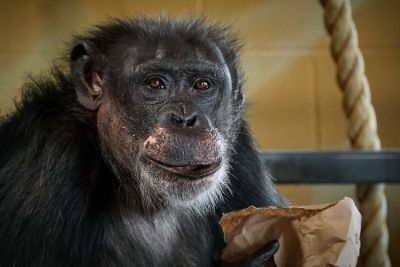
Communication between chimpanzee residents and human caregivers
APRIL 25, 2022
IN CHIMPS
BY CLAUDE DESROCHERS
When I first started working at Fauna I had difficulty telling the residents apart. I found it really incredible how the other caregivers could identify each of them with such ease. I knew that over time I would discover each of the residents’ unique personalities as well as their distinctive physical traits, however, what impressed me the most was that the caregivers were able to identify which resident was communicating with them without even seeing the individual in question. How was this possible? I would soon learn that each resident has a unique way of communicating with their caregivers.
Like humans, chimpanzees communicate with a complex system with gestural and vocal communication. When it comes to communicating with humans they have developed strategies to compensate for their inability to speak. These strategies enable them to capture the attention of caregivers and to communicate different needs, such as asking for certain food that isn’t on their carts, or wanting to play or groom with a caregiver, etc.
Following are the different sounds and noises that our residents make that allow us to recognize each individual without necessarily seeing them.
I noticed that the males at Fauna all make the same sound to communicate with us. They produce a sound called a “Bronx Cheer”. This is a sound made with the mouth that resembles flatulence noises (yes yes, you read that right!). Binky, Loulis and Regis all communicate using this sound. However, the pitch and rhythm of the sound varies by individual, which helps us determine which chimpanzee is communicating with us. Binky makes the loudest Bronx Cheer and also occasionally produces a ”Huu” sound, which is most often used in a sequence of “huu huu huu’s”. The sounds that Regis emits however, have a slower rhythm and are much softer than Binky’s. He also makes a sneezing-like sound when he gets impatient. Finally, Loulis makes a much quieter Bronx Cheer than the other two males. So much so that sometimes we can barely hear it.
The Fauna females have a much wider spectrum of sounds. Tatu, who communicates using American Sign Language, taps on her own head to get our attention; a modified sign that means “PERSON” and functions like “Hey you!” since it makes noise. Chance, on the other hand, uses a variety of very distinctive sounds. It’s a bit difficult to explain these sounds in writing, but they are usually used in a sequence and produced by smacking her lips together in different ways. Maya is much less subtle than the others. She bangs the outside of her fist vigorously on the cage to emit a series of “Bang bang bangs”! Rachel uses various different strategies. Sometimes she simply claps her hands. When feeling playful, she’ll clap her hands and feet together. Like Maya, she’ll also sometimes bang on the enclosure when she really wants something. Sue Ellen is more discreet. We don’t often hear her asking for attention from caregivers. When we do hear her “Pant hoot’’ or “Pant grunt,” it’s often because she sees or hears a man nearby (because she has a particular affection towards men). In these cases she is no longer discreet and wants to have all the attention she can get from them!
Why can’t chimpanzees talk like humans?
The answer is simple. Their vocal anatomy is not adapted to speech. Unlike adult humans, the positioning of the larynx is higher in the throat in chimpanzees, not unlike in human babies. So, because of this anatomical difference, chimpanzees are unable to use their vocal cords like humans do. However, they have a lot to say with their hands. For example, Tatu and Loulis communicate with us using American Sign Language. Tatu learned this from humans and Loulis learned from other chimpanzees!
To learn more on this subject, please visit the Friends of Washoe website: www.friendsofwashoe.org
Claude Desrochers




